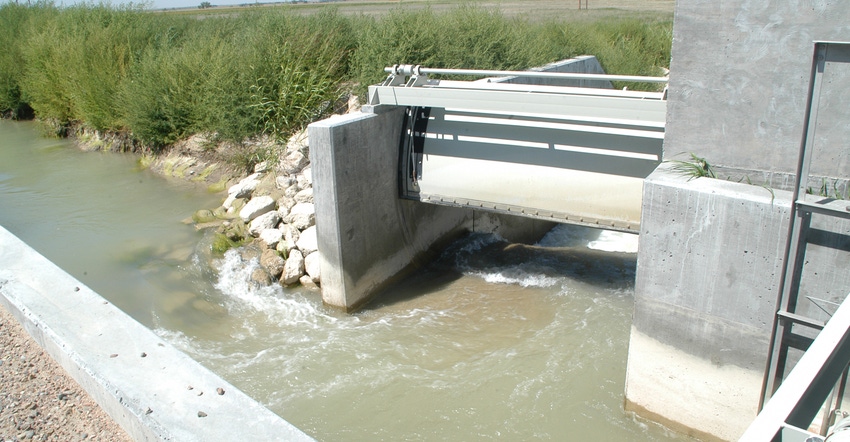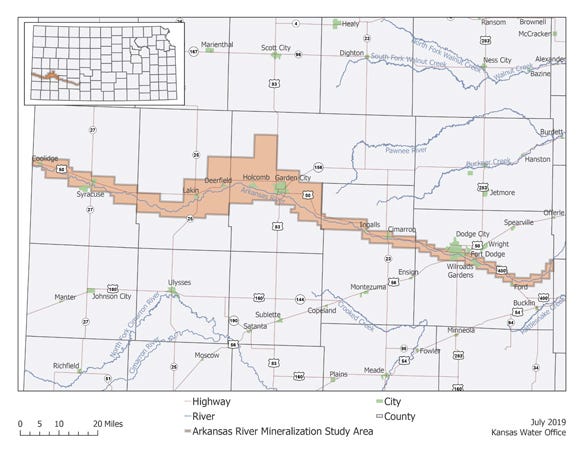
It has been more than 15 years since the Kansas Geological Survey first collected data from water wells in the Arkansas River region of southwest Kansas to determine the level of contamination of the groundwater from naturally occurring sources.
Now, the Kanas Water Office, along with the Kansas Department of Health and Environment, the Kansas Department of Agriculture, Groundwater Management District 3 and KGS, is undertaking a two-year study to collect current, updated data in the areas adjacent to the river and surface irrigation canals in Hamilton, Kearny, Finney, Gray and Ford counties.
The study was authorized by legislation passed during the 2019 legislative session.
People who live in the area and use their wells for drinking water can have their water tested for naturally occurring minerals that may be hazardous to health without charge. Test results will be given to the well owners and will be used to help determine overall regional groundwater quality.
 STUDY AREA: This map shows the study area. Landowners who use their wells for drinking water will be able to have their water tested without charge.
STUDY AREA: This map shows the study area. Landowners who use their wells for drinking water will be able to have their water tested without charge.

Water from public supply water systems is routinely tested to make sure that it meets all safe drinking water standards and is not included in the new study.
County health departments and conservation districts have water sampling kits that they will make available to private well owners. The phased study will start in Hamilton County, followed by Kearny, Finney, Gray and Ford counties. Participation is voluntary.
The 13 primary substances and measures that will be included in the parameter of the study are:
1. Alpha particles. Heavy, high energy particles emitted from "mildly radioactive" elements. Alpha particles do not have the energy to breach the outer layer of skin. However, once inside the body they can be very harmful. High levels of alpha radiation can be harmful because alpha particles can damage cells and genetic material, which can lead to cancer.
2. Arsenic. A naturally occurring element found in the earth's crust. Arsenic is also a by-product of copper smelting, mining, coal burning, and other industrial processes, along with agricultural processes. High levels of arsenic in water supplies are difficult to identify because symptoms are the same as other illnesses.
3. Beta particles. Small, high energy particles emitted from "mildly radioactive" elements. Beta particles are less damaging than alpha particles, but some are capable of breaching skin. Like alpha particles, they are most harmful once inside the body. Being smaller than alpha particles, beta particles can travel further and faster but can be stopped by most solid objects.
4. Chloride. A chemical compound that occurs naturally as a component of salts. Chloride salts are widely used in snow and ice control and in the production of industrial chemicals, including fertilizers. Natural resource extraction can also produce areas with elevated levels of chloride. High levels of chloride in water supplies can be indicated by the water having a salty taste. Chloride is considered a “nuisance chemical” by EPA, which means it may cause cosmetic or aesthetic effects in drinking water. In high concentrations, chloride may erode pipes and well casings.
5. Iron. A non-hazardous element that is chemically similar to manganese and can cause similar problems. Iron is more common than manganese, and both are considered “nuisance chemicals” by EPA. High levels of iron in water supplies can be indicated by the water having a rust color and metallic taste. It can also cause laundry stains.
6. Manganese. A non-hazardous element that is chemically similar to iron and can cause similar problems. High levels of manganese in water supplies can be indicated by the water having a black to brown color and bitter metallic taste. It can also cause black staining.
7. Nitrogen. Nitrogen is essential for all living things and exists in the environment in varying forms throughout the nitrogen cycle. Nitrate is most harmful in infants under 6 months of age. Without specific testing, high levels of nitrate in water supplies are undetectable.
8. Radium. A naturally occurring radioactive metal that emits alpha particles as it decays. This can lead to higher concentrations of alpha particles in water supplies. Radium also eventually decays into radon, which can also be a cause for health concerns without testing because it is tasteless, colorless and odorless.
9. Selenium. A metal found in natural deposits. Its most common use is in electronics, but it can also be found in nutritional supplements, glass, paints, enamels, inks, plastics and rubber, along with pesticides and as an additive for livestock feed. Selenium is essential at low levels; however, too much can cause various health effects.
10. Specific conductivity. A measure of water's ability to pass an electrical current. Specific conductivity relates directly to the concentration of ions in the water. Significant changes in conductivity can indicate that changes to the condition of the water have taken place. High salinity levels can indicate high conductivity levels.
11. Sulfate. An inorganic compound that is considered a secondary water contaminant or “nuisance chemical” by EPA and at concentrations found in domestic water supplies it does not usually pose a health risk. An indicator that high levels of sulfate exist in a water source is if the water has a salty taste.
12. Total dissolved solids. The sum of all ion particles that are smaller than 2 microns. Total dissolved solids are considered a “nuisance chemical” by EPA and aren't harmful on their own. However, high TDS concentrations can indicate a problem with harmful ions that can cause health concerns. High concentrations of TDS in water supplies can be indicated by a salty taste, deposits, hardness and colored water.
13. Uranium. A chemical element that is found naturally in nearly all soil, rock and water. Uranium decays by creating alpha particles, so high concentrations of uranium can also lead to high concentrations of alpha particles. When uranium decays, it eventually becomes radium. So, it can also ultimately lead to high levels of radium as well.
Go online for more information or call 785-296-3185.
This article contains information supplied by the Kansas Water Office.
About the Author(s)
You May Also Like






